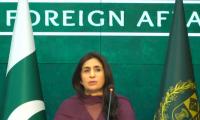KARACHI: The International Monetary Fund (IMF) on Tuesday trimmed Pakistan’s growth forecast to 2.9 percent in 2019 and 2.8 percent in 2020 amid ongoing macroeconomic adjustment challenges, saying twin deficits warrant further structural reforms.
The country’s growth stalled in the current fiscal year as external account sector weakened, while revenue-expenditure gap continues to widen.
The current account and fiscal deficits are expected to bring the growth down from a decade-high of 5.2 percent in the last fiscal year of 2017/18.
“In Pakistan, in the absence of further adjustment policies, growth is projected to remain subdued at about 2.5 percent, with continued external and fiscal imbalances weighing on confidence,” the IMF said in its World Economic Outlook before its spring meetings in Washington this month.
The country is in talks with the Washington-based lender for its 13th economic assistance program since the late 1980s.
The projections came close on the heels of fragile growth forecasts by the Asian Development Bank and the World Bank.
Both the international financial institutions projected real gross development
product at 3.4 to 3.9 percent in the current fiscal year as the measures to bring the economy on track are expected to take toll on growth.
The central bank raised its key policy rate by a cumulative 500 basis points to 10.75 percent since January 2017.
Rupee that lost a quarter of its value against the dollar over a year kept consumer inflation on the upward trajectory and in March alone, annual consumer inflation reached more than five years high of 9.41 percent.
The IMF projected consumer inflation at 7.6 percent in 2019 and 7 percent in 2020 compared with 3.9 percent in 2018. The IMF, however, expected current account deficit to narrow at 5.2 percent in 2019 and 4.3 percent in 2020 as opposed to 6.1 percent in 2018.
While Finance Minister Asad Umar said the economy has come back to stabilisation mode with foreign inflows of more than three billion dollar replenishing the country’s foreign exchange reserves, he said the country is still facing challenges, including stalled investment and narrow tax base.
The minister recently said the country is weeks away from securing an IMF bailout and hoped an agreement would be reached with the fund by late April or first half of May for a package of anywhere between $6 billion to $12 billion.
The government has been criticised for taking months to close an IMF bailout, its
second since it secured a $6.6bn loan from the international body in 2013, as the country wrestles with a severe balance of payments crisis.
The IMF further kept projection for unemployment rate unchanged at 6.1 percent in 2019 compared with the previous year and ratcheted it up to 6.2 percent in 2020.
The IMF too remained pessimistic over Pakistan’s growth forecast in the medium term as the Fund projected growth at 2.5 percent in 2024.
Consumer inflation was projected at five percent and current account deficit at 5.4 percent in 2024.
The IMF foresaw deceleration in growth in the region to 1.5 percent in 2019, before recovering to about 3.2 percent in 2020.
“The medium-term outlook for the Middle East, North Africa, Afghanistan, and Pakistan region is largely shaped by the outlook for fuel prices, needed adjustment to correct macroeconomic imbalances in certain economies, and geopolitical tensions,” it said in the report, “World Economic Outlook: Growth Slowdown, Precarious Recovery”.
Sheikh argued that the government should have maintained stable petroleum prices
MARI has successfully drilled and tested the third appraisal well in the Ghazij formation in the Mari D&PL
Gold rates decreased by $17 to $2,395 per ounce in the international market
Company's revenue saw a 13.9% year-on-year increase, reaching Rs49.2 billion, up from Rs43.19 billion in the same...
A man counts US dollars in a money exchange shop in Dhaka. — AFP/FileLAHORE: The first thing that the government...
Power generation stood at 8,741 gigawatt-hours or 11,749 megawatts in March







